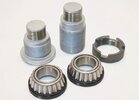I'm still sitting here, carefully rereading your post to make sure I don't miss anything and to fully grasp the content.
One thing is for sure, you are not alone being puzzled by the swing arm torque sequence.
This morning, I meticulously checked for any play in my swing arm, following
@dduelin's recommendations.
I found no play, leading me to believe that the bearings are tight and correctly torqued. To be absolutely certain, I even shacked the swing arm between two sturdy aluminum U-shaped legs while using a laser marker and micrometer to measure lateral and vertical movement. There was no variation.
Fortunately, any potential modifications would have introduced additional trial and error as you mentioned it.
Next, I removed the handlebars, riser, and loosened the steering head bearings adjusting nut by 3 or 4 millimeters using my fingers (no torque wrench). I then retorqued the steering bridge stem nut to 76 lb-ft and took the bike for a ride.
The improvement was dramatic. The steering is now nearly perfect, with no more feeling of the bike rolling beneath me. It's much less sensitive to tar snakes and feels more neutral.
As you said, all the difference in the world.
I've adjusted these settings at least 10 times in the past year, always double-checking with a pulling scale. Each time, I thought I'd finally found the optimal setting, only to discover that I was wrong.
I remain concerned about the long-term stability of these settings. Will they require readjustment within the next 5,000 kilometers?
I've learned that a torque wrench is often unnecessary when installing tapered roller bearings on the ST. Finger-tight is sufficient and no torque wrench will give you that feeling.
In my 40 years of motorcycle ownership, I've never encountered such unpredictable behavior as I've experienced on this ST. I've now realized that this bike's geometry is extraordinarily sharp and sensitive.
I'm truly grateful for your advice and assistance. Thank you!
Sidekick


